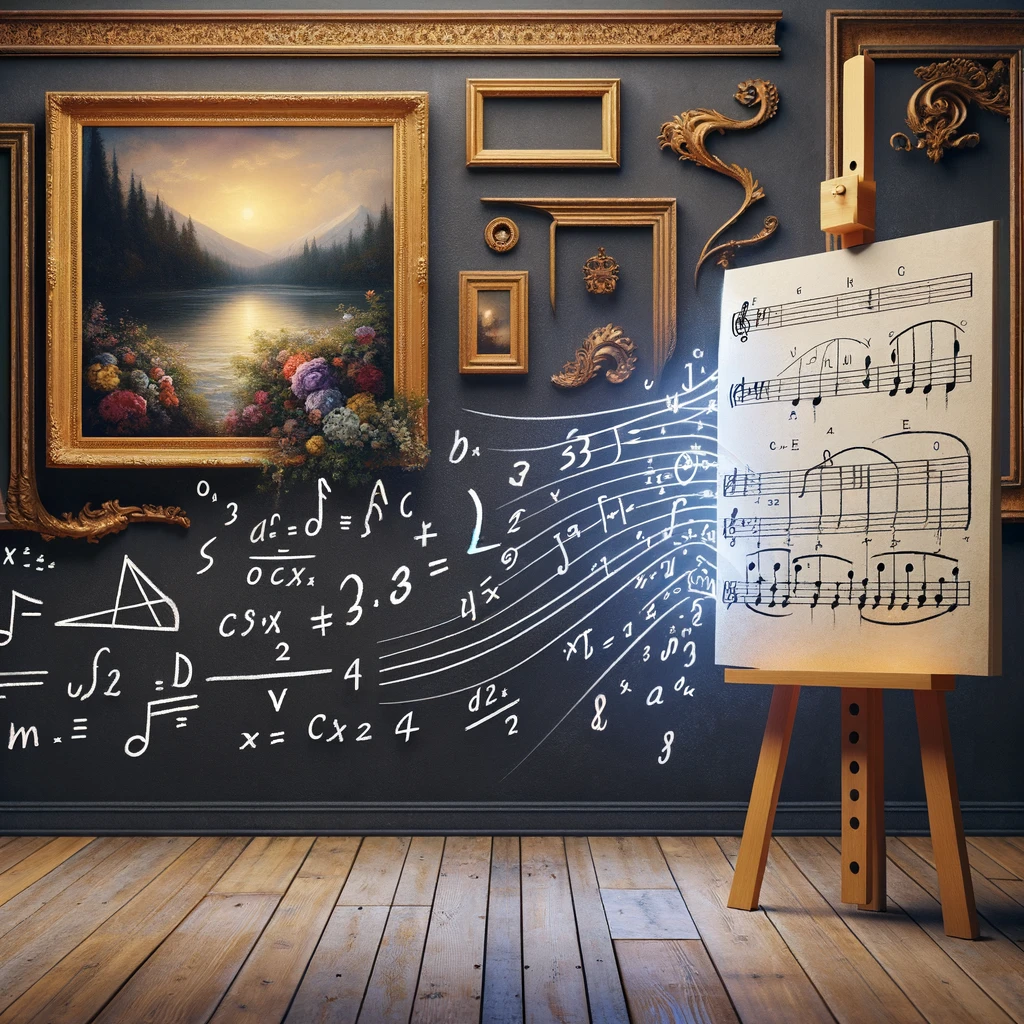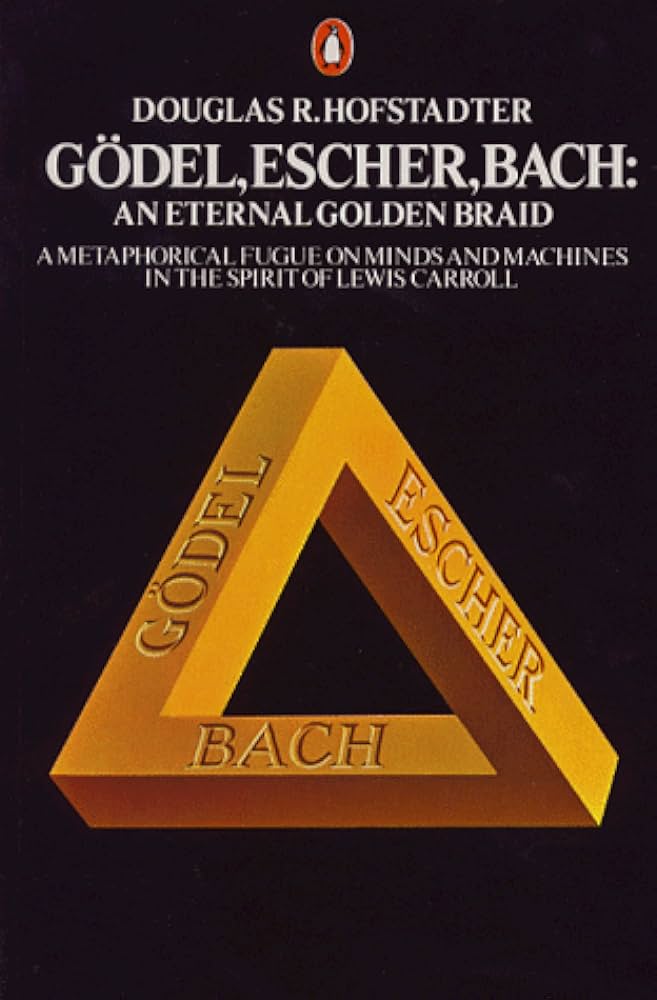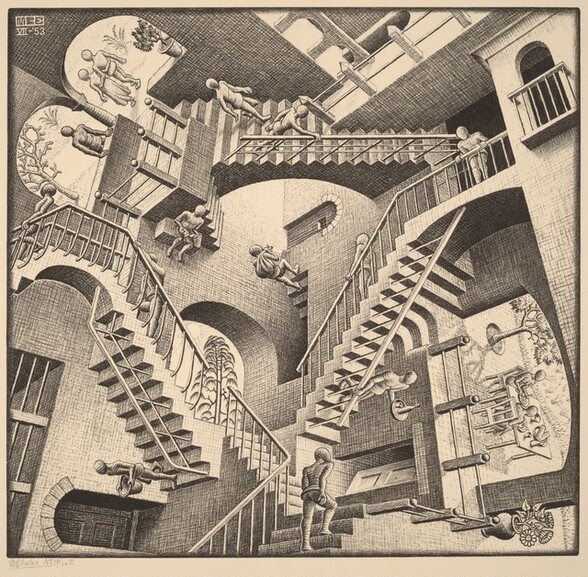“I try to awaken wonder and astonishment in the viewer. Are you really sure that a floor can’t also be a ceiling?” Escher
Douglas Hofstadter’s “Gödel, Escher, Bach” is an intricate and enlightening examination of the mind’s architecture, weaving together the unlikely disciplines of mathematics, art, and music to explore the nature of consciousness and self-awareness.
Book Overview in Themes
- Introduction to Formal Systems: Introduces the concept of formal systems, using simple examples to prepare the reader for more complex discussions.
- Gödel’s Incompleteness Theorems: Explains Gödel’s theorems and their implications for mathematics and beyond, suggesting inherent limitations in formal systems.
- Escher’s Art and Symmetry: Explores how M.C. Escher’s artwork plays with perception and infinity, paralleling the themes of recursion and self-reference found in mathematics and music.
- Bach’s Musical Structures: Discusses J.S. Bach’s compositions, particularly the fugues and canons, as examples of complex, self-referential structures that mirror the book’s central themes.
- Minds and Machines: Delves into the question of what it means to be conscious and how systems can exhibit mind-like properties.
Powerful Quotes
- “Every letter is a part of a puzzle, and every puzzle reflects the whole.”
- “In the world of ideas, recursion is the key to ‘strange loops’ and self-awareness.”
- “A system cannot understand itself completely without stepping outside of itself.”
- “Art, at its core, is a reflection of the mind’s infinite capabilities to perceive and reinterpret the world.”
- “Music is not just sound but structured sound – a mirror to the patterns of thought itself.”
- “Consciousness arises from the complex interplay of simple components.”
- “Language shapes our thoughts, and yet it is also shaped by them in a continuous feedback loop.”
- “Infinity lies not in vastness but in self-reference and recursion.”
- “True understanding requires transcending linear thought, embracing the cyclical and recursive.”
- “The beauty of a system lies in its complexity and its potential for self-examination.”
Book Review
Douglas Hofstadter’s “Gödel, Escher, Bach: An Eternal Golden Braid” is a masterful tapestry that interlaces the mathematical, artistic, and musical threads into a cohesive exploration of consciousness and identity. Through its engaging dialogues, intricate analogies, and thorough analysis, GEB challenges readers to ponder the nature of self-awareness and the potential for artificial intelligence to achieve a similar state of being. Hofstadter’s work is both a celebration of human creativity and a philosophical inquiry into the patterns that define our existence.
At its core, GEB is an intellectual journey through the loops and layers of thought and expression, encouraging readers to see beyond the surface of complex systems and appreciate the underlying unity of knowledge. Hofstadter’s ability to draw profound connections across disparate fields makes the book a seminal work in understanding the puzzles of the mind and the universe. It remains as relevant and thought-provoking today as it was at the time of its publication, a testament to its enduring appeal and the depth of its inquiries.

“The aim and final end of all music should be none other than the glory of God and the refreshment of the soul.” Bach
Interesting Lessons from the Book
- The interconnectedness of all knowledge and the importance of interdisciplinary thinking.
- The limits of formal systems and the implications for understanding the mind.
- The beauty and complexity of self-reference and how it relates to consciousness.
“Douglas Hofstadter’s “Gödel, Escher, Bach: An Eternal Golden Braid” (GEB) is profound for several reasons, most notably its ambitious exploration of how consciousness might emerge from well-defined, inanimate systems. It navigates the intricate interplay between the rigid structures of mathematics, the perceptual shifts found in art, and the layered complexities of music to propose a unified theory of mind and meaning. Here are the main lessons and profound insights we can derive from the book:
The Unity of Knowledge
GEB illustrates that seemingly disparate academic disciplines—mathematics, art, and music—share deep, intrinsic connections that reflect the underlying patterns of the universe. Hofstadter’s exploration teaches us the value of interdisciplinary thinking and the potential for holistic understanding when we bridge gaps between fields.
Underlying Patterns of the Universe
The underlying patterns of the universe include mathematical laws, physical constants, and natural patterns (such as fractals) that govern the structure and behavior of everything from subatomic particles to galaxies. These patterns reveal a consistency and order that underpin the complexity of the cosmos.
The Nature of Consciousness and Self-Reference
One of the book’s central themes is the exploration of consciousness through the lens of self-reference and recursive structures, known as “strange loops.” Hofstadter suggests that the self-awareness characteristic of human consciousness might arise from the complex feedback loops within the brain, akin to the recursive symbols and themes in Gödel’s theorems, Escher’s drawings, and Bach’s fugues. This challenges us to think about consciousness not as a mystical quality but as an emergent property of certain kinds of symbolic systems.
The Limits and Power of Formal Systems
Through Gödel’s Incompleteness Theorems, Hofstadter presents a powerful lesson on the limitations of formal systems in capturing the totality of truth. Gödel proved that in any sufficiently complex axiomatic system, there are true statements that cannot be proven within the system’s own rules. This teaches us about the inherent limitations of our attempts to fully understand the universe through science and logic alone, highlighting the importance of humility and open-mindedness in intellectual pursuits.
Examples of True Statements That Can’t Be Proven
An example from Gödel’s work involves statements in arithmetic that essentially say, “This statement cannot be proven to be true within this system.” If the system could prove the statement, it would be inconsistent (because the statement says it can’t be proven); if the system can’t prove the statement, then the statement is true, but unprovable within the system. This paradox highlights the limitations of formal systems.
Another Example of True Statements That Can’t Be Proven
Consider the statement related to the concept of large cardinal numbers in set theory, a branch of mathematical logic. One such statement might assert the existence of certain types of large cardinals that cannot be proven to exist using the standard axioms of set theory (like ZFC – Zermelo-Fraenkel set theory with the Axiom of Choice). These large cardinal axioms add new layers of infinity beyond those describable by standard set theory, and their implications can’t be fully captured or proven by the existing system, suggesting there are truths about mathematical infinities that elude proof within the framework.
Explaining this concept to a 5 year old
Imagine you have a box of crayons that can color any picture you want. Now, think of a super special crayon that can color pictures so big and so magical that no one has ever seen them before. This crayon is so special that even if everyone believes it can color these amazing pictures, no one can actually prove it can do it by just using the crayons and coloring books they already have.
So, even though we think this super crayon exists because we can imagine the wonderful pictures it can color, we can’t use our regular crayons or coloring books to show everyone that it’s real. It’s like knowing there are more colors out there that we just can’t see with our own eyes or color with our crayons yet!
The Importance of Loops, Recursion, and Patterns
Hofstadter’s fascination with loops and recursion serves as a metaphor for understanding complex systems, including our own minds. He shows how patterns that feed back into themselves are foundational to creating complexity from simplicity. This insight has implications not just for cognitive science but for understanding the structure of the universe, the nature of art and music, and the development of artificial intelligence.
Why It’s Important to Create Complexity from Simplicity
Creating complexity from simplicity allows for the emergence of new properties and behaviors that are not evident from the simpler components alone. This principle is seen in nature, where simple rules can lead to rich and diverse ecosystems, and in technology, where basic elements combine to form complex networks. It shows how dynamic systems, including life itself, can evolve and adapt.
Embracing Complexity and Paradox
GEB encourages readers to embrace the complexity and paradoxes of life. Hofstadter delights in presenting puzzles, paradoxes, and thought experiments that challenge conventional thinking, thereby fostering a mindset that is comfortable with complexity and ambiguity—essential qualities for navigating the modern world.
The Interconnectedness of All Things
Ultimately, GEB teaches us that everything is connected. The book itself is a testament to the beauty of weaving together diverse threads of thought into a coherent tapestry. It serves as a reminder that our attempts to compartmentalize knowledge into discrete disciplines only limit our understanding and that true insight comes from recognizing the interconnectedness of all things.
Examples of Interconnectedness
- Ecosystems: In an ecosystem, plants, animals, and microorganisms interact with each other and their physical environment in a way that sustains life. The removal or addition of one species can have cascading effects on the whole system.
- The Internet: The internet is a global network of computers connected in a complex web of data exchange. A piece of information can travel through numerous nodes, affecting and being affected by countless other data points along the way.
- Economics and Global Markets: The global economy is a tightly interconnected system where a financial event in one part of the world can have immediate impacts on markets thousands of miles away, demonstrating the economic interdependence of nations.
- Human Body: The human body is an example of interconnected systems where the functioning of one organ or system (like the circulatory system) is deeply interlinked with and dependent on the functioning of others (like the respiratory system).
Examples of Unexpected Interconnectedness
- Jellyfish and Climate Change: The population boom of jellyfish in various parts of the world is interconnected with climate change. Warmer ocean temperatures, overfishing of natural predators, and increased nutrients from agricultural runoff favor jellyfish blooms, which in turn affect marine ecosystems and human activities, like clogging cooling systems of coastal power plants.
- Bee Populations and Coffee Production: The health of bee populations is intricately linked to the production of coffee, among many other crops. Bees play a crucial role in pollinating coffee plants, directly affecting yield and quality. Declines in bee populations due to pesticides, habitat loss, and climate change can thus have a significant impact on coffee production and prices.
- Social Media Use and Sleep Patterns: The use of social media and electronic devices is interconnected with sleep patterns and quality. Blue light emitted by screens can disrupt circadian rhythms, affecting sleep. Furthermore, the content consumed can increase stress or anxiety, further impacting sleep, which in turn affects overall health and productivity.
- Antibiotics in Agriculture and Human Health: The use of antibiotics in livestock farming is interconnected with antibiotic resistance in humans. Antibiotics used in animal feed to promote growth can lead to the development of antibiotic-resistant bacteria, which can spread to humans through the food supply, making some bacterial infections harder to treat.
- Financial Markets and Coral Reefs: There’s an unexpected link between financial markets and coral reef health. Investment and insurance companies are increasingly recognizing the economic value of healthy coral reefs in protecting coastlines from storms and supporting fisheries and tourism. As a result, financial instruments are being developed to fund reef restoration and conservation, tying the health of these ecosystems to financial market dynamics.
Even More Unexpected Interconnectedness
- Slime Mold and City Planning:
- Slime mold, a single-celled organism without a brain, has been used to model and optimize complex human systems like city transportation networks. Researchers have observed that when slime mold is placed on a map with food sources located at major urban centers, it grows its network in patterns strikingly similar to existing transportation systems, such as the Tokyo rail network. This unexpected connection between biology and urban planning highlights how understanding biological processes can inspire efficient, cost-effective solutions in city development and transportation logistics.
- Shark Skin and Antibacterial Surfaces:
- The study of shark skin, specifically its unique pattern of denticles (tiny, tooth-like structures), has led to the development of antibacterial surfaces in hospitals. Shark skin is known to be resistant to bacteria due to these microscopic patterns that prevent microorganisms from attaching and growing. By mimicking this pattern, scientists have created surfaces that significantly reduce bacterial growth without the need for chemical disinfectants. This crossover between marine biology and healthcare technology showcases the potential for nature-inspired innovations in creating safer, cleaner environments.
- Lotus Leaves and Self-cleaning Materials:
- The lotus leaf is famous for its superhydrophobic properties, meaning it can repel water and remain clean, as dirt particles are carried away by water droplets due to a phenomenon known as the Lotus Effect. This effect has been studied and applied to create self-cleaning paints and coatings for buildings, cars, and textiles. The interdisciplinary study of botany and materials science has led to the development of products that stay cleaner longer, reducing the need for cleaning and maintenance and the environmental impact associated with them.
These examples illustrate the profound benefits of interdisciplinary research and the innovation that can occur when insights from one field are applied to challenges in another. By bridging the gaps between seemingly unrelated areas of study, researchers can uncover novel solutions to complex problems, demonstrating the vast potential of a cross-disciplinary approach to knowledge and discovery.
In summary, “Gödel, Escher, Bach” is profound not only for the breadth of its exploration but for the depth with which it examines the puzzles of consciousness, the nature of self-reference, and the beauty of interconnected knowledge. It challenges us to see the world, and ourselves, in a new light, making it a timeless piece of literature that continues to inspire curiosity and wonder.”
Who is the Author?
Douglas Hofstadter is an American scholar, author, and professor of cognitive science. His interests span a wide range of disciplines, including consciousness, analogy-making, and the sense of “I.” Hofstadter’s work often explores the intersections of mathematics, art, and music, reflecting his belief in the deep connections that bind different fields of inquiry. He received the Pulitzer Prize for General Non-Fiction for “Gödel, Escher, Bach” in 1980, cementing his reputation as a brilliant and accessible science writer.
8 Main Critiques of the Book
- Some readers find the book’s dense and meandering narrative challenging to follow.
- Critics argue that Hofstadter’s analogies, while creative, sometimes stretch too far and obscure rather than clarify his points.
- The heavy reliance on dialogues inspired by Lewis Carroll has been seen as overly whimsical for the subjects discussed.
- Some mathematicians and scientists argue that Hofstadter oversimplifies complex concepts, making them misleading.
- The book’s length and complexity can be daunting, potentially discouraging casual readers.
- Critics have noted that Hofstadter’s speculation on the nature of consciousness and AI might be overly optimistic or speculative.
- The interdisciplinary approach, while innovative, can sometimes lead to a lack of depth in exploring individual fields.
- Hofstadter’s focus on Western cultural artifacts (Gödel’s theorems, Escher’s art, and Bach’s music) may limit the book’s scope in exploring universality in patterns and thought.
Related Books for Further Exploration
- “I Am a Strange Loop” by Douglas Hofstadter – Expands on the concept of “strange loops” and self-reference introduced in GEB.
- “The Mind’s I” by Douglas Hofstadter and Daniel Dennett – A collection of writings on the philosophy of mind, consciousness, and identity.
- “Metamagical Themas” by Douglas Hofstadter – A compilation of Hofstadter’s Scientific American columns, exploring topics ranging from logic and paradox to linguistics and artificial intelligence.
- “How to Create a Mind” by Ray Kurzweil – Discusses the pattern recognition theory of mind and prospects for building intelligent machines.
- “The Recursive Universe” by William Poundstone – Explores the concept of recursion through the lens of Conway’s Game of Life, touching on topics similar to those in GEB.
“I don’t believe in empirical science. I only believe in a priori truth.” Gödel

